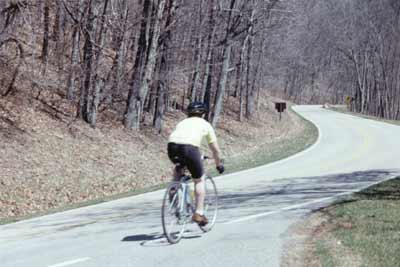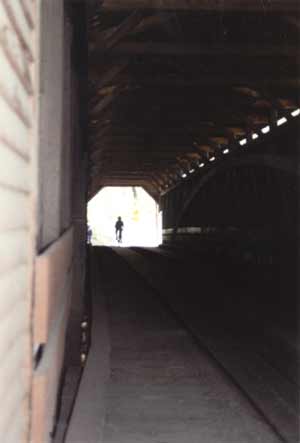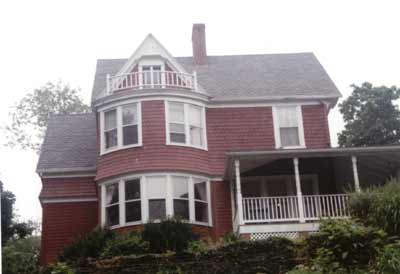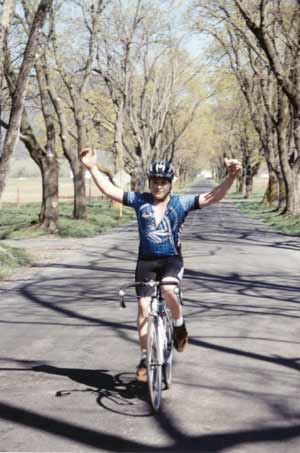 Training in the Blue Ridge Mountains |
The C&O Canal National Park
|
 Training in the Shenandoah Valley |
When my son was in training for a 150-mile bike tour with the Multiple Sclerosis Society I can honestly say I enjoyed all of his training rides (as well as the actual event). He trained in the Blue Ridge Mountains and in the Shenandoah Valley. The Chesapeake and Ohio Canal National Park (C&O) offered an off-road, unpaved alternative that was flat, allowing for a different kind of training on his mountain bike. Since I had heard many wonderful things about the C&O Canal, I was thrilled to finally get to explore this unique national park. The fact that we were able to reserve a night at Highacre, the premier accommodation offered through the Potomac Appalachian Trail Club (PATC), made it even more enticing. Today, the C&O Canal offers an incredible biking/hiking trail that is relatively flat and quite easy to navigate. Its length is 184.5 miles, stretching from Georgetown to Cumberland, Maryland. Along the way, you will see wildflowers, wildlife, locks, lockhouses, and aqueducts. This project was begun in 1828, with the ambition of building a canal to Pittsburg (connecting the Ohio River to the Chesapeake Bay). Although the original goal was never met and the work ended in Cumberland in 1850, there was still the completed 184.5 miles between Georgetown and Cumberland. Twenty years later, in the 1870s, the canal was making a profit transporting mostly coal (but also lumber, stone, grain, flour, and whiskey). At one point, over 500 boats were working on the canal. |
After the flood of 1924, the canal closed permanently due to repeated flooding, winter freezes, dry spells, and the competition of the railroad. In 1939 the Franklin D. Roosevelt authorized the Civilian Conservation Corps to work on the first 22 miles of the C&O Canal, clearing the towpath of 15 years of overgrowth, removing rocks and debris from the canal, repairing breaches in the canal caused by the 1924 and 1936 floods and restored numerous locks to working order. By 1971, it was designated a National Historical Park insuring that this paradise would not be paved. The Park Service is now responsible for its maintenance and visitors are given the wonderful opportunity to experience this well cared for gem.
 |
 |
Along the "Towpath"
The "trail" that parallels the canal is really a "towpath." When used for transporting goods, mules walked the towpath pulling the boats. They needed 74 locks because of the elevation changes along the way. Not many locks are still operational but in Georgetown, visitors can actually ride a mule-powered boat through a lock with rangers and volunteers in period costumes providing a living history of the canal in a one-hour tour that can be enjoyed by all ages. The tour is well worth the rate of $8.00 for adults and $5.00 for children 14 - 4 (those under three years old are free).
 |
"Highacre"
There are a total of six visitor centers along the length of the canal.
We visited three and found the rangers to be helpful and the maps to be
excellent. Serious cyclists can complete the entire 184.5 miles in two
days; others can expect to spend three or four days on this trek. Along
the way guests will find campsites or nearby hotels or bed & breakfasts.
Harper's Ferry is a fantastic place to stop and explore. This old town
is on a hillside overlooking the convergence of the Shenandoah and Potomac
rivers. Like Thomas Jefferson, we visited this historic settlement when
rains had the waters high and raging. Down a short distance from Highacre
(the PATC house), we found the famous Jefferson Rock where Jefferson
himself stood and described the view with the following words:
The passage of the Patowmac through the Blue Ridge is perhaps one of the most stupendous scenes in nature. On your right comes up the Shenandoah, having ranged along the foot of the mountain an hundred miles to seek a vent. On your left approaches the Patowmac, in quest of a passage also. In the moment of their junction they rush together against the mountain, rend in asunder, and pass off to the sea…This scene is worth a voyage across the Atlantic.
If you are interested in more history of the C&O Canal, I would recommend you read The C&O Canal Companion by Mike High. (ISBN number 0-8018-6602-2) In addition to a fascinating story, you will be given complete information on all sections of the trail. This book is easy to use as a guidebook but I do recommend you pick up one of the free maps available at the visitor center. Because of the daily work of the park rangers, maintenance staff, and volunteers who monitor the towpath on a daily basis, we found the towpath to be quite well maintained and safe.
Learn more about the C&O by clicking here.
 |
Copyright ©2003-Mary Wilson-All Rights Reserved
QUESTIONS...COMMENTS...IDEAS...
Mary Wilson...
Email: mary@trailz.org
Go back to Happy Trails Home Page